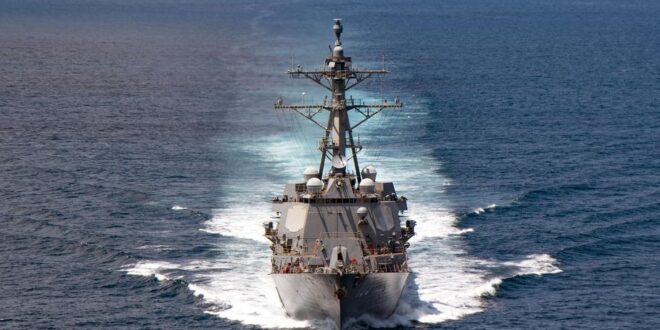Navy leaders are strengthening their commitment to developing more advanced weapons and other capabilities over some traditional ships to challenge the increasing aggression from China and Russia around the globe, according to the service’s 2022 Navigation Plan released Tuesday.
“Retiring legacy platforms that cannot stay relevant in contested seas — and investing in the capabilities we need for the future — is essential for our national security,” the Navy wrote in the document that lays out the service’s long-term priorities.
Citing China’s ongoing efforts to build its military rapidly and Russia’s dismantling of the post-Cold War peace in Europe when it invaded Ukraine in February, the service said prioritizing new capabilities and weapons will be key to future conflicts, according to the document.
“The world is entering a new age of warfare, one in which the integration of technology, concepts, partners, and systems — more than fleet size alone — will determine victory in conflict,” the service said in the document.
The navigation plan helps lay out the service’s requirements for Congress, which has been hesitant to allow the Navy to cut ships as China grows its fleet, Adm. Mike Gilday, chief of naval operations, told reporters Wednesday.
“There’s more work to be done with the Hill, particularly with respect to composition of the force — explaining ourselves better with respect to that composition, the why behind it,” Gilday said about explaining the Navy’s plan for the force to lawmakers.
In its 2023 proposed budget, the Navy said it wants to cut 24 ships next year to save $3.6 billion in the next five years that could be used to develop new technologies. They included nine Freedom-class littoral combat ships, five Ticonderoga-class cruisers, two Los Angeles-class submarines, four landing dock ships, two oilers and two expeditionary transfer dock vessels.
Whether Congress will allow the Navy to cut 24 ships remains in question. Last year, lawmakers ordered the Navy to build 13 ships in the fiscal 2022 budget in pursuit of a larger fleet after service leaders asked for just eight.
Some lawmakers, such as Rep. Rob Wittman, R-Va., spoke out against the ship cuts since the budget was made public March 28, noting the strategy “prioritizes future technologies over the capacity and capabilities service members need now.”
“I am particularly disappointed that even as we aim to grow our naval and projection forces, this budget continues the divest-to-invest strategy that will shrink our fleet once again,” the congressman said at the time.
The service wants to “shift to a larger, more capable Navy” that incorporates “a host of manned, unmanned and operationally manned platforms,” according to the document.
The Navy is required by Congress to reach a fleet of 355 ships “as soon as possible” under the 2018 National Defense Authorization Act, which sets the military’s goals and spending priorities. Its new plan calls for a “hybrid fleet” of more than 350 warships, about 150 unmanned ships and underwater vehicles, and approximately 3,000 aircraft by the 2040s, according to the document.
“The why behind the composition and the size is grounded on how we’re going to fight,” Gilday said. “In short, it is our intent to face any adversary with our forces spread out with our effects masked across multiple vectors, both physically and virtually in all domains from the seabed to space.”
Six new priorities
The plan for the future force is broken down into six categories: distance, deception, defense, distribution, delivery and decision advantage.
“The six different force design imperatives are informed by the challenges that we’ve seen based on the rise of China,” Gilday said.
The service wants to “expand distance” by developing and focusing on long-range weapons that allow the Navy to strike an enemy from further away, thus “increasing our own survivability” against a potential counterattack, according to the plan.
Leveraging deception will be done by prioritizing capabilities such as stealth and electronic warfare technologies to “degrade enemy surveillance and increase adversary uncertainty,” allowing the Navy to operate more effectively in battle.
The Navy aims to “harden defense” by incorporating directed energy weapons such as high-powered lasers alongside traditional weapons such as missiles to disrupt attacks by adversaries.
“Increasing distribution” will be done by spreading out the force across the world and focus on building “smaller, lethal and less costly platforms,” such as unmanned ships, according to the plan. The idea is to “further complicate threat targeting, generate confusion and impose dilemmas” for adversaries.
By “ensuring delivery,” the service aims to boost logistics to keep the fleet sustained with supplies at sea and strengthening its communications technologies, which are key to keeping ships engaged in battle, according to the plan.
Finally, the Navy will “generate decision advantage” through communication technologies and artificial intelligence that will connect sensors and weapons across the world, according to the plan. The tools should allow warfighters more time to make quicker decisions about incoming threats.
“Naval forces will out-sense, out-decide and out-fight any adversary by accelerating our decision cycles with secure, survivable and cyber (attack)-resilient networks, accurate data and artificial intelligence,” according to the plan.
China and Russia
The changes are necessary so the Navy can keep up with “a battlespace that is quickly growing in lethality and complexity,” according to the document.
For example, China has tripled the size of its Navy since the early 1990s, expanded its nuclear weapons capabilities, advanced its cyber and space capabilities and developed long-range weapons and hypersonic missiles, the Navy said.
“These investments in offensive warfighting systems — across all domains — are aimed at the heart of America’s maritime power,” according to the document. “China designs its force for one purpose: to reshape the security environment to its advantage by denying the United States military access to the western Pacific and beyond.”
Additionally, Russia’s ongoing war in Ukraine also presents a challenge to the United States. Russia seeks to “fracture NATO and reestablish its sphere of influence” and threaten global peace with nuclear threats, cyberattacks and submarine deployments near American shores, according to the document.
The Navy, which handles about “70% of America’s deployed nuclear arsenal” on platforms such as submarines, will play a major role in countering such threats, according to the document.
“Decisive naval power is essential in this security environment. America cannot cede the competition for influence,” the document said. “A combat-credible U.S. Navy … remains our nation’s most potent, flexible and versatile instrument of military influence.”
 Eurasia Press & News
Eurasia Press & News




